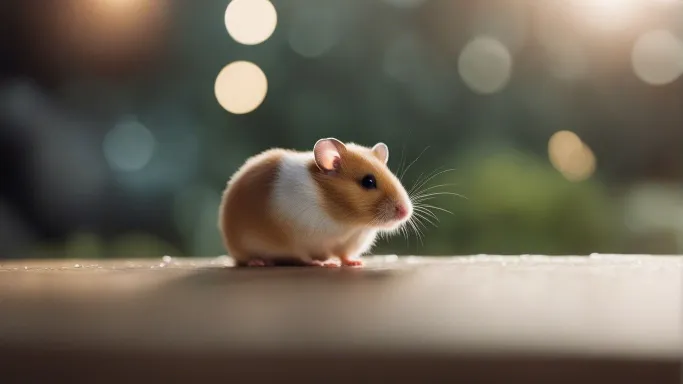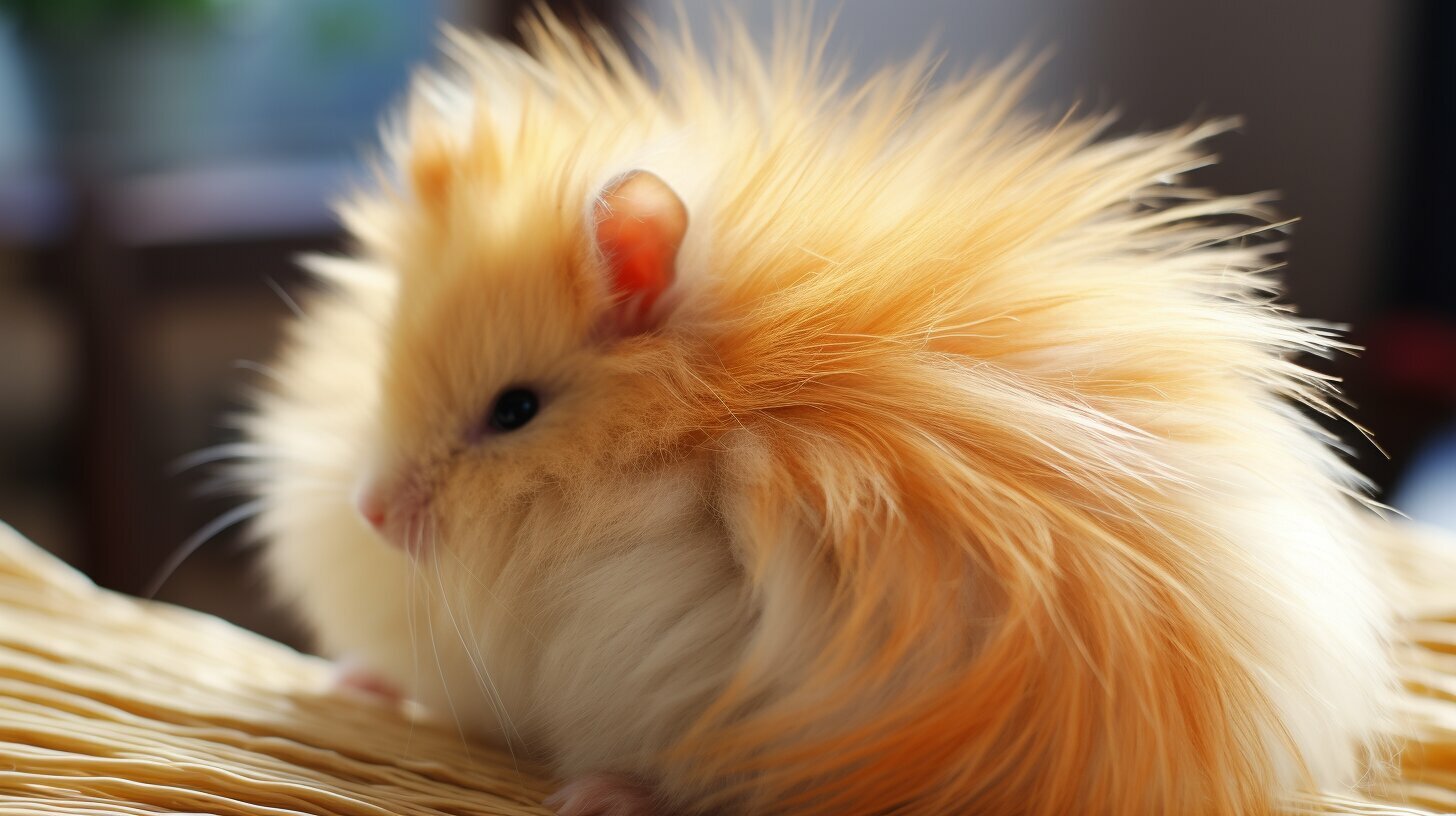Hamsters do have tails, although they are often very small and not easily visible. The length of a hamster’s tail can vary depending on the breed.
For example, Syrian hamsters have short, stubby tails that are less than half an inch long, while Chinese hamsters have longer tails that can grow up to one inch.
The main reason for hamsters having short tails is that they are burrowing animals, and long tails would get in the way when digging underground.
The purpose of hamster tails is not fully understood, but they may help with balance and protecting the sensitive rear end.
Hamsters can suffer from a serious condition called wet tail, which is characterized by watery diarrhea and can be fatal if not treated immediately.
Hamsters cannot regrow their tails if they are injured, and their tails do not fall off as a defense mechanism. The condition and appearance of a hamster’s tail can indicate its overall health.
Key Takeaways:
- Hamsters have tails, although they are often small and not easily visible.
- Tail length can vary depending on the hamster breed.
- Short tails are beneficial for burrowing hamsters.
- The purpose of hamster tails is still not fully understood.
- Wet tail is a serious health condition that can be fatal if not treated immediately.
- Hamsters cannot regrow their tails if they are injured.
- The condition and appearance of a hamster’s tail can indicate its overall health.
Hamster Tail Length and Characteristics
The length of a hamster’s tail can vary depending on the breed. For example, Syrian hamsters have short, stubby tails that are less than half an inch long, while Chinese hamsters have longer tails that can grow up to one inch. These tail lengths are measured from the base of the tail to the tip.
Hamsters have tails that are covered in fur, just like the rest of their bodies. However, their tails are often not easily visible because they are short and blend in with their fur. In fact, some people may mistake a hamster for being tailless due to the small size of their tails.
It is important to note that the main reason for hamsters having short tails is their burrowing nature. Hamsters are known for their digging abilities, and long tails would be a hindrance when they are digging underground. The short tail allows them to maneuver and navigate through tunnels and burrows more easily.
The purpose of hamster tails is not fully understood, but they may serve a role in balance and protecting the sensitive rear end. Hamsters use their tails to help maintain stability while climbing, running, and jumping. Additionally, the tail can help protect the hamster’s posterior region from potential injuries.
| Hamster Breed | Tail Length |
|---|---|
| Syrian Hamsters | Less than half an inch |
| Chinese Hamsters | Up to one inch |
In conclusion, the length and characteristics of a hamster’s tail depend on the breed. Short tails are common among hamsters, and they serve a purpose in their burrowing behavior.
While the exact purpose of hamster tails is not fully understood, they play a role in balance and protecting the sensitive rear end.
It is important to provide proper care and attention to a hamster’s tail as part of their overall well-being.
Purpose of Hamster Tails
The purpose of hamster tails is not fully understood, but they may help with balance and protecting the sensitive rear end.
Hamsters have tails that are often very small and not easily visible. The length of a hamster’s tail can vary depending on the breed.
For example, Syrian hamsters have short, stubby tails that are less than half an inch long, while Chinese hamsters have longer tails that can grow up to one inch.
Hamsters are burrowing animals, and their short tails are believed to be an adaptation for their underground lifestyle.
Long tails would get in the way when digging tunnels and burrows. By having short tails, hamsters can navigate through narrow spaces more efficiently.
Additionally, their tails may assist with balance and help them maintain stability while moving around their habitat.
While the exact purpose of hamster tails remains a mystery, they also play a role in protecting the hamster’s rear end.
The tail acts as a barrier and provides a layer of defense against potential injuries or threats. It helps shield the sensitive area, reducing the risk of harm during activities such as running, climbing, and exploring.
To summarize, hamster tails serve a purpose in helping with balance and protecting the sensitive rear end. Their length varies among different hamster breeds, with short tails being common due to the burrowing nature of these adorable rodents.
| Fact 1 | Fact 2 | Fact 3 |
|---|---|---|
| Hamster tails are often very small and not easily visible. | Short tail length is an adaptation for their burrowing lifestyle. | The purpose of hamster tails is not fully understood. |
| Long tails would get in the way when digging tunnels and burrows. | Hamster tails help with balance and stability. | They also provide protection for the sensitive rear end. |
Wet Tail and Hamster Health
Hamsters can suffer from a serious condition called wet tail, which is characterized by watery diarrhea and can be fatal if not treated immediately. Wet tail is most commonly seen in young hamsters, especially those who are under stress or have a weakened immune system. The exact cause of wet tail is not fully understood, but it is believed to be caused by an overgrowth of harmful bacteria in the hamster’s digestive system.
If you notice that your hamster is displaying symptoms of wet tail, such as diarrhea, lethargy, and a wet or matted coat around the tail area, it is crucial to seek veterinary attention right away. Wet tail can quickly lead to dehydration and weight loss in hamsters, which can be life-threatening. A veterinarian will be able to diagnose the condition and prescribe appropriate treatment, which may include antibiotics and supportive care.
Preventing wet tail in hamsters is crucial for their overall health and wellbeing. Stress is a common trigger for wet tail, so it is important to provide a calm and comfortable environment for your hamster. Keep their living space clean and provide them with a balanced diet to help support their immune system. Regularly monitoring your hamster’s behavior and health can also help you catch any potential issues early on.
| Signs of Wet Tail | Prevention Tips | Treatment and Care |
|---|---|---|
|
|
|
Remember, early detection and prompt treatment are vital in managing wet tail in hamsters. By providing a stress-free environment and proactive care, you can help keep your hamster healthy and prevent the development of this serious condition.
Injury and Tail Regrowth
Hamsters cannot regrow their tails if they are injured, and their tails do not fall off as a defense mechanism. Unlike some other animals, such as lizards, hamsters do not possess the ability to regenerate lost or damaged tails. Therefore, it is crucial to prevent any injuries to their tails to ensure their overall well-being.
A hamster’s tail is a delicate appendage that is susceptible to various types of injuries. These injuries can occur as a result of accidents, mishandling, or getting caught in objects within their habitat. It is important to provide a safe and secure environment for your hamster to minimize the risk of tail injuries.
To prevent tail injuries, make sure to choose appropriate cage accessories and toys that do not have small openings or sharp edges. Regularly inspect your hamster’s habitat for any potential hazards that could harm their tail. Additionally, handle your hamster gently and avoid pulling or tugging on their tail, as this can cause unnecessary stress and potential harm.
Safe and Comfortable Tail Care
To promote a healthy tail, it is essential to practice good hygiene and cleanliness in your hamster’s habitat. Regularly clean their bedding and keep their living area free from any waste or leftover food particles that could attract bacteria or pests. This will help prevent infections and maintain a clean and comfortable environment for your hamster.
| Tip 1: | Take time to carefully choose cage accessories and toys without potential hazards that could harm their tail. |
|---|---|
| Tip 2: | Handle your hamster gently, avoiding any excessive pulling or tugging on their tail. |
| Tip 3: | Regularly clean their bedding and keep their living area free from waste or leftover food particles. |
By following these tips and providing a safe and clean environment, you can help ensure the well-being and overall health of your furry friend, including their precious tail.
Tail Appearance and Health Indication
The condition and appearance of a hamster’s tail can indicate its overall health. A healthy hamster will have a tail that is smooth, clean, and devoid of any sores or injuries. The tail should be held upright and not drooping or dragging on the ground.
Additionally, a healthy hamster’s tail will have a good amount of fur coverage, indicating proper grooming and hygiene. The fur on the tail should be soft and shiny, without any matting or bald spots. If you notice any changes in the appearance of your hamster’s tail, such as redness, swelling, or discharge, it could be a sign of an underlying health issue that requires attention.
It’s also important to observe the behavior of your hamster in relation to its tail. A healthy hamster will use its tail for balance and coordination. You may notice your hamster using its tail to help maintain stability while climbing or navigating its environment. If your hamster is consistently dragging its tail or keeping it tucked under its body, it could be an indication of discomfort or injury.
| Signs of a Healthy Hamster Tail | Signs of Potential Health Issues |
|---|---|
| – Smooth and clean | – Redness or swelling |
| – Upright position | – Discharge |
| – Good fur coverage | – Changes in behavior |
| – Soft and shiny fur | – Dragging or tucking the tail |
If you notice any concerning signs related to your hamster’s tail, it’s best to consult a veterinarian who specializes in small animal care. They will be able to examine your hamster and provide appropriate treatment if necessary. Remember, maintaining a healthy and happy tail is an important aspect of overall hamster care.
Hamster Tailless Varieties
In addition to hamsters with tails, there are also tailless hamster varieties. These unique breeds have naturally shorter or absent tails, which sets them apart from their tailed counterparts. One such example is the Roborovski hamster, also known as the Robo dwarf hamster. This small and agile species originates from the deserts of Mongolia and China and tends to have a very short, stubby tail that is barely noticeable.
Another well-known tailless hamster variety is the Campbell’s dwarf hamster. This breed, originating from the steppes of Central Asia, also has a short tail that is often difficult to see due to its size. The Campbell’s dwarf hamster is recognized for its playful and social nature, making it a popular choice among hamster enthusiasts.
When it comes to tailless hamster breeds, it’s important to note that while they may have shorter or absent tails, they still possess the same general traits and care requirements as their tailed counterparts. They still require regular feeding, exercise, and proper habitat to thrive. Additionally, tailless hamsters can exhibit the same behaviors, such as burrowing and exploring their surroundings.
| Tailless Hamster Varieties | Tail Characteristics | Origin |
|---|---|---|
| Roborovski Hamster (Robo dwarf hamster) | Very short, stubby tail | Mongolia, China |
| Campbell’s Dwarf Hamster | Short tail | Central Asia |
Overall, tailless hamster varieties offer a unique twist on the cuddly and curious nature of these small pets. While they may not have the conventional long tail, they still make delightful companions for hamster enthusiasts.
Hamster Anatomy and Tail Placement
The tails of hamsters are positioned in a specific location in relation to their overall anatomy. Hamsters, known for their small size and round bodies, have tails that are short and inconspicuous.
These tails are located at the rear end of the hamster’s body, extending out from just below the spine. While hamsters are generally recognized for their adorable faces and furry bodies, their tails play a crucial role in their overall anatomy.

One interesting fact about hamster tails is that they are not actually visible from the front, as they are usually hidden beneath the hamster’s body. Due to their burrowing nature, hamsters have evolved to have short tails that do not hinder their ability to dig and navigate underground. This compact tail placement allows hamsters to move freely through tunnels and burrows without obstruction. Their tails are also relatively thin and flexible to ensure ease of movement.
Although the function of hamster tails is not fully understood, it is believed that they serve multiple purposes. One possibility is that hamster tails play a role in maintaining balance, especially while climbing or navigating narrow pathways. Additionally, the tail may help to protect the hamster’s sensitive rear end from potential injuries or external threats.
| Hamster Anatomy | |
|---|---|
| Body | The body of a hamster is compact and rounded, covered in fur that can vary in color and texture depending on the breed. |
| Head | The head of a hamster is characterized by a pair of small, round ears and beady black eyes. They also have sharp incisors for gnawing on various objects. |
| Paws | Hamsters have four paws, each equipped with sharp claws that aid in climbing and digging. |
| Tail | The tail of a hamster is short and located at the rear end of its body. It is not easily visible from the front. |
In conclusion, the tails of hamsters are a unique feature of their anatomy, positioned in a specific location to accommodate their burrowing nature. While their exact purpose is still being studied, hamster tails are thought to assist with balance and provide protection to their delicate rear end. Understanding the anatomy of a hamster, including their tails, is essential for providing proper care and ensuring the overall well-being of these adorable small pets.
Caring for Hamster Tails
Proper care is essential to maintain the health of a hamster’s tail. Although small and often hidden, a hamster’s tail plays a crucial role in their overall well-being. To ensure your hamster’s tail remains healthy, here are some important tips to keep in mind:
- Grooming: Regular grooming is vital to prevent matting and tangling of the tail fur. Use a soft brush or a damp cloth to gently clean the tail, removing any debris or dirt that may accumulate.
- Cleanliness: Like any other part of a hamster’s body, the tail should be kept clean and free from any signs of infection. Regularly check the tail for any redness, swelling, or discharge, as these may indicate an underlying health issue.
- Handling: When handling your hamster, be careful not to pull or tug on their tail. Hamsters can be sensitive, and rough handling may cause them distress or even injury. Always support the hamster’s body and be gentle when holding them.
- Preventing injuries: Provide a safe and secure environment for your hamster to prevent tail injuries. Avoid placing small openings or gaps in their enclosure that may trap or pinch their tail, and ensure that any toys or accessories are free from sharp edges.
“Proper care is essential to maintain the health of a hamster’s tail.”
In addition to these guidelines, it’s important to monitor your hamster’s overall health. A healthy hamster will have a tail that appears clean, well-groomed, and free from any abnormalities. If you notice any changes in the appearance or behavior of your hamster, including their tail, it’s best to consult a veterinarian experienced in small animal care.
| Tail Care Tips: | |
|---|---|
| Grooming | Regularly clean the tail to prevent matting and tangling. |
| Cleanliness | Check the tail for any signs of infection or inflammation. |
| Handling | Be gentle and avoid pulling or tugging on the hamster’s tail. |
| Preventing injuries | Create a safe environment and remove any potential hazards. |
By following these care guidelines, you can help ensure that your hamster’s tail remains healthy and contributes to their overall well-being.
Interesting Facts About Hamster Tails
Did you know that hamster tails have some interesting features? Despite their small size, these tails play a significant role in a hamster’s life. Let’s explore some fascinating facts about hamster tails!
- Balance and Communication: Hamster tails are believed to help with balance, especially when they are navigating narrow spaces or climbing. The tail acts as a counterbalance, allowing the hamster to maintain stability. Additionally, hamsters use their tails to communicate with each other. They can twitch or wag their tails to convey different emotions or intentions.
- Distinctive Appearance: While hamster tails are generally short, they are still visible if you look closely. The tail is covered in fur and matches the color of the hamster’s body. Some hamsters have tails that are slightly longer than others, but it is a small appendage compared to their bodies.
- No Regrowth: Unlike certain reptiles or amphibians, hamsters are unable to regrow their tails if they are injured. It is crucial to handle these delicate creatures with care to avoid any harm to their tails. Be gentle and support their bodies when picking them up to prevent any accidents.
- Health Indicator: The condition of a hamster’s tail can provide insights into its overall health. A healthy hamster will have a tail that is well-groomed, free from any signs of injury or infection, and with a good fur coverage. If you notice any changes in the appearance of your hamster’s tail, it might be a sign that something is amiss, and it’s essential to seek veterinary attention.
Hamster tails may be small, but they serve important functions in these adorable little creatures. Take the time to observe and appreciate the unique features of your hamster’s tail, and remember to prioritize their well-being by providing proper care and attention!
| Tail Function | Characteristics |
|---|---|
| Balance | Helps with stability during movement |
| Communication | Tail twitches and wags convey emotions or intentions |
| Appearance | Short, fur-covered tails that match the hamster’s body color |
| Regrowth | Hamsters cannot regrow their tails if injured |
| Health Indicator | A well-groomed, injury-free tail signifies good overall health |
Conclusion
In conclusion, hamsters do have tails, although they are often small and not easily visible. The length of a hamster’s tail can vary depending on the breed. For example, Syrian hamsters have short, stubby tails that are less than half an inch long, while Chinese hamsters have longer tails that can grow up to one inch.
The main reason for hamsters having short tails is that they are burrowing animals, and long tails would get in the way when digging underground. Although the exact purpose of hamster tails is not fully understood, they may aid in balancing and protecting the sensitive rear end.
It’s important to note that hamsters can suffer from a serious condition called wet tail, which is characterized by watery diarrhea. Wet tail can be fatal if not treated immediately. Additionally, it is not possible for hamsters to regrow their tails if they are injured, as their tails do not fall off as a defense mechanism.
The condition and appearance of a hamster’s tail can provide valuable insight into its overall health. It is crucial for hamster owners to monitor their pet’s tail for any signs of abnormality or injury. Regular grooming and cleanliness are also essential to maintain a healthy tail.
FAQ
Q: Do hamsters have tails?
A: Yes, hamsters do have tails, although they are often very small and not easily visible.
Q: How long are hamster tails?
A: The length of a hamster’s tail can vary depending on the breed. Syrian hamsters have short, stubby tails that are less than half an inch long, while Chinese hamsters have longer tails that can grow up to one inch.
Q: Why do hamsters have short tails?
A: Hamsters have short tails because they are burrowing animals, and long tails would get in the way when digging underground.
Q: What is the purpose of hamster tails?
A: The purpose of hamster tails is not fully understood, but they may help with balance and protecting the sensitive rear end.
Q: What is wet tail and can it be fatal?
A: Wet tail is a serious condition in hamsters characterized by watery diarrhea. It can be fatal if not treated immediately.
Q: Can hamsters regrow their tails if they are injured?
A: No, hamsters cannot regrow their tails if they are injured. Their tails do not fall off as a defense mechanism.
Q: Can the condition and appearance of a hamster’s tail indicate its overall health?
A: Yes, the condition and appearance of a hamster’s tail can indicate its overall health. A healthy tail is a sign of a healthy hamster.
Q: Are there any tailless hamster varieties?
A: Yes, there are tailless hamster varieties. These tailless breeds have unique characteristics.
Q: Where is the tail located on a hamster’s body?
A: The tail is located on a hamster’s rear end, near the base of its body.
Q: How should I care for my hamster’s tail?
A: Proper hamster tail care involves regular grooming and cleanliness to maintain a healthy tail.
Q: What are some interesting facts about hamster tails?
A: Hamster tails have unique characteristics and behaviors that make them interesting.




